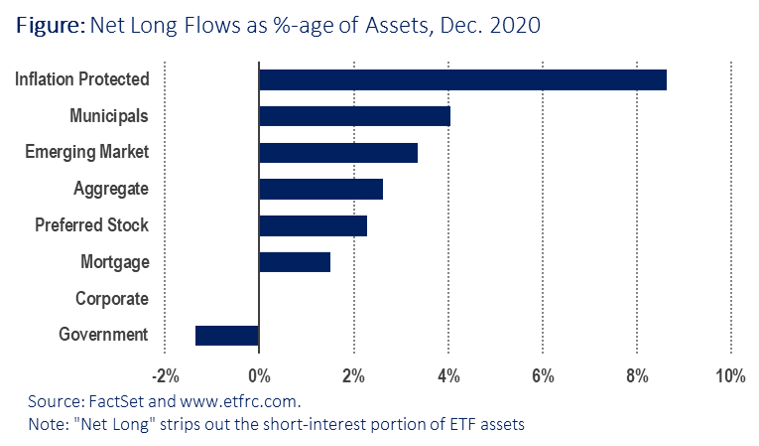
Money flooding into ETFs slowed in December, capping off a historically strong year. Analysis of the flow data suggests that while in some aspects investors were growing more cautious, they also continued to allocate fresh money to “risk-on” areas of the market.
Welcome to the 4th issue of Flow Charts, a monthly summary of fund flow data from our ETF universe. As a reminder, we take a slightly different approach than the typical fund flow analysis by stripping out the short interest portion of each ETF to arrive at a “Net Long” figure for dollar flows.
Since authorized participants can create new ETF shares simply to meet demand from short sellers, such “inflows” should not be equated with bullish investors putting new money to work on the long side. (Likewise, “outflows” that reflect the closing out of short positions should not be seen as bearish.)
By netting out these short interest positions, we believe this presents a more accurate picture of where other investors are truly bullish, and where they are bearish. That said, here is what the data revealed for the month of December 2020.
The tidal wave of ETF money slowed in December as investors clashed between caution and optimism
Net Long ETF inflows were $43.2 billion in December, a little more than half of the record $83.6 billion taken in during November. As the chart below illustrates, the “Net Long” flows were also lower than flows measured the traditional way, as short interest increased slightly across both equity and fixed income ETFs, indicating that more investors view the market rally as over-extended. As a percentage of assets under management (AUM), equity net inflows amounted to an increase of 1.0%, while fixed income’s increase was 1.6%.
The top five ETFs for net inflows in December included a much talked-about newcomer to the big leagues in third place:
- Vanguard Total Stock Market (VTI, +$5.2 billion net inflows)
- iShares MSCI Emg. Markets (IEMG, +$4.0 billion)
- ARK Innovation ETF (ARKK, +$3.0 billion)
- iShares TIPS Bond ETF (TIP, +$2.8 billion)
- Vanguard Total Bond Market ETF (BND, +$2.3 billion)
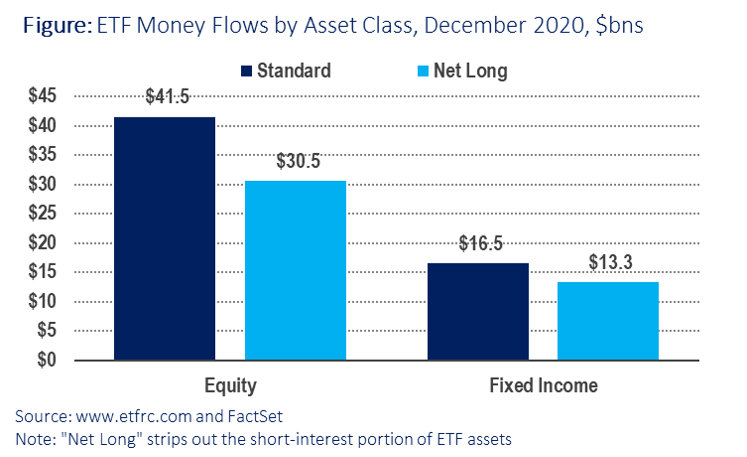
Investors may have engaged in a bit of performance chasing, putting more new money to work (as a percentage of starting AUM) in small and mid-cap ETFs than their large-cap counterparts. Bellwether funds representing these market cap segments like the iShares Russell 2000 (IWM) returned 8.6% during December while the S&P MidCap 400 SPDR (MDY) was up 6.5%. The S&P 500 gained 3.7%.
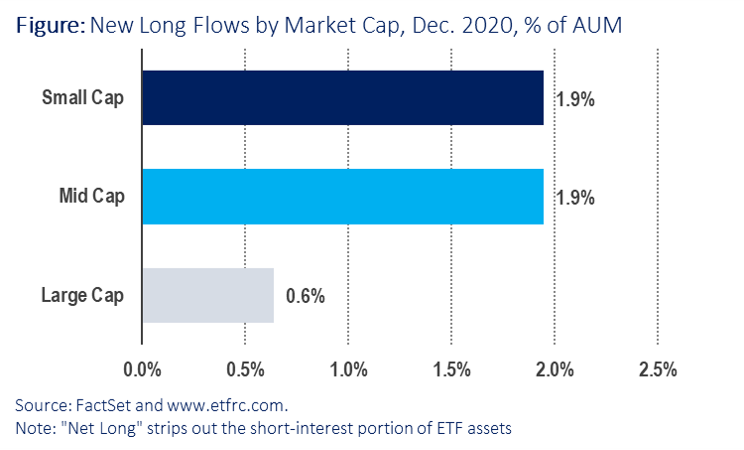
The flows into small and mid caps would have been even greater had there not been a significant uptick in short interest in both of these areas. Short interest among small caps grew from 11.9% to 13.2%–a big change for these fairly stable figures–to become the most shorted category. Meanwhile short interest for mid caps rose from 11.4% to 12.0%. Short interest for large caps remained steady at 11.6% (chart below)
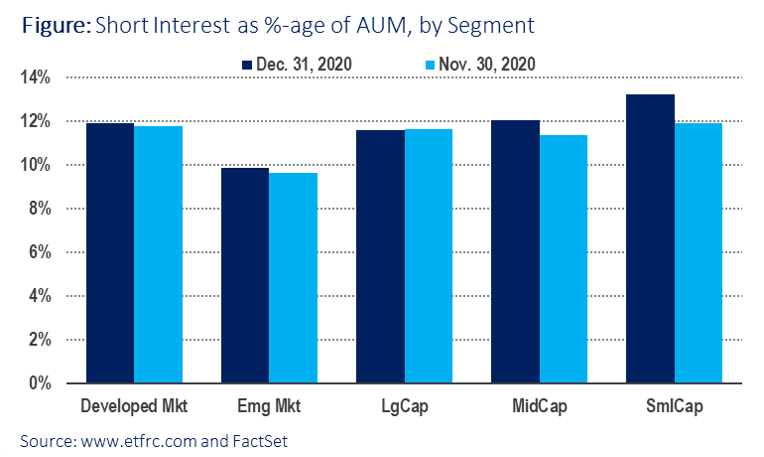
Once again, the Technology sector was the biggest recipient of new capital, followed closely by Financials, which were also the two best performing U.S. large cap sectors last month. But in percentage terms, Real Estate and Basic Materials–two underperforming sectors–were the biggest recipients of new money.
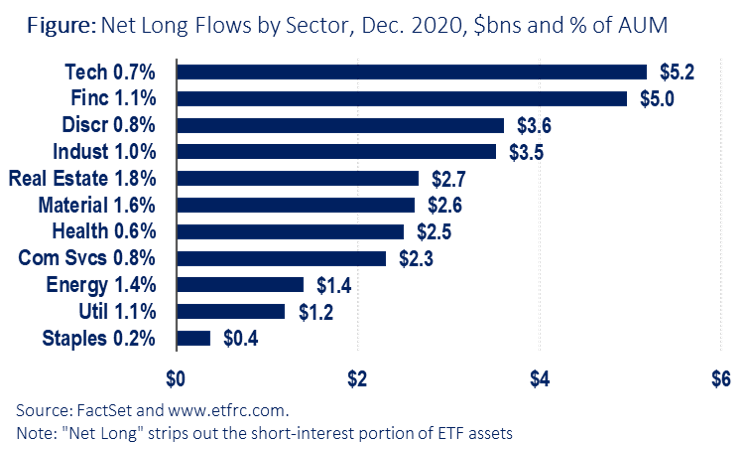
Allocation between foreign and domestic stocks however indicated a big shift in favor of the former. Although domestic equities took in the largest dollar amount at $11.6 billion, as a percentage of assets that amounts to just 0.4%.
Developed and Emerging Markets took in slightly less cash overall, but the new funds amounted to 1.9% and 3.6% of AUM, respectively, indicating investors were increasing their overall allocation towards these areas. Representative funds such as the iShares MSCI EAFE (EFA) and iShares Emerging Markets (EEM) beat their U.S. counterpart in the S&P 500 SDPR (SPY) handily in December.
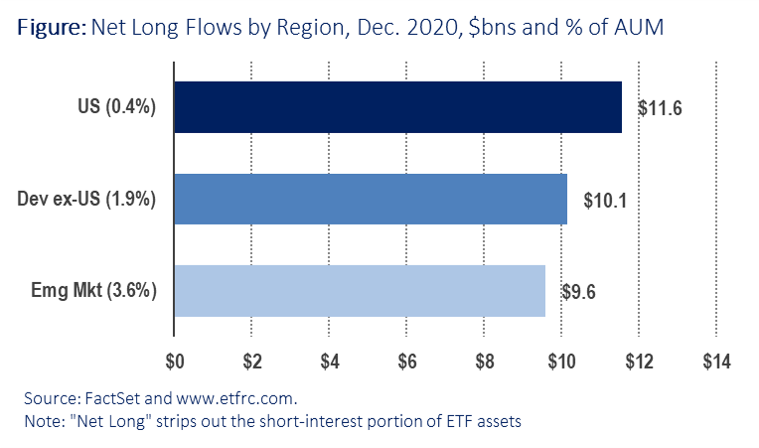
On the fixed income side, investors piled into Inflation Protected bonds funds like iShares TIPS Bond ETF (TIP), #4 on our list above, presumably out of concern about additional stimulus sparking inflation. As a percentage of assets, new money grew in these funds by 8.6%, a big change for a single month. Meanwhile investors yanked 1.4% of assets out of standard Treasuries (a.k.a. Government funds).
